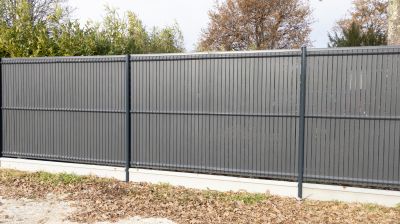Leading Selection of Aluminum Fence Accessories for Easy Setup
Equip your fencing project with trusted accessories that enhance stability, appearance, and installation efficiency.
 Installing an aluminum fence requires a combination of durable materials and reliable accessories to ensure a secure and aesthetically pleasing boundary. Aluminum fencing is valued for its corrosion resistance, low maintenance, and versatile design options, making it suitable for residential, commercial, and decorative applications. A successful installation begins with selecting the right components, including posts, rails, panels, and hardware, all designed to work together seamlessly.
Installing an aluminum fence requires a combination of durable materials and reliable accessories to ensure a secure and aesthetically pleasing boundary. Aluminum fencing is valued for its corrosion resistance, low maintenance, and versatile design options, making it suitable for residential, commercial, and decorative applications. A successful installation begins with selecting the right components, including posts, rails, panels, and hardware, all designed to work together seamlessly.
Top Overall Option
Aluminum Fence Post System
An aluminum fence post system designed for versatility and durability offers a comprehensive solution for various installation scenarios. It includes posts, caps, and mounting hardware, allowing for secure attachment of panels and rails. Its corrosion-resistant construction ensures longevity, while compatibility with multiple styles makes it suitable for different aesthetic preferences. This type of system simplifies the installation process by providing all essential components in one package, making it a reliable choice for both DIY enthusiasts and professional installers.
Types of Products For Aluminum Fence Installations
Aluminum Fence Posts
Posts serve as the primary support structure, available in various heights and styles to match different fencing designs.
Fence Panels
Pre-assembled panels are designed to connect between posts, offering quick and uniform installation options.
Railings and Rails
Horizontal components that connect posts and support the panels, often adjustable for different fence heights.
Mounting Brackets and Clamps
Hardware used to secure panels and rails to posts, ensuring stability and alignment.
Gate Hardware
Hinges, latches, and handles specifically designed for aluminum gates to ensure smooth operation.
Caps and Finials
Decorative or protective caps for posts and panels that enhance appearance and prevent water infiltration.
Concrete Footings
Foundation supports used to anchor posts into the ground for added stability.
Surface Mount Brackets
Hardware that allows for attaching fence components to existing structures or surfaces.
Corner and End Posts
Specialized posts designed for corners and ends to provide structural integrity and aesthetic finish.
Decorative Elements
Ornamental accessories like scrolls or finials to customize the fence design.
Fence Repair Kits
Components for maintaining or replacing damaged sections of aluminum fencing.
Fasteners and Screws
High-quality screws and fasteners compatible with aluminum to ensure secure assembly.
Popular Choices
A commonly selected component, available in various styles to match different fencing needs.
Prefabricated panels that facilitate quick installation and consistent appearance.
Flexible rails that allow for customization of fence height and spacing.
Durable hinges designed for smooth operation and long-term use.
Secure latching mechanisms suitable for aluminum gates and fencing panels.
Caps that add aesthetic appeal while protecting the post tops from weather damage.
Reliable anchors for securing posts into concrete or ground surfaces.
Easy-to-install hardware for attaching fence components to existing structures.
Special connectors that facilitate secure corner and end post assembly.
Popular accessories for adding personalized decorative touches.
Widely used components for maintaining the integrity of existing fences.
Corrosion-resistant screws for secure assembly of aluminum fencing parts.
The foundation of any aluminum fence installation is the posts, which provide stability and support for the entire structure. Posts can be anchored into the ground using various methods such as concrete footings, surface mounts, or sleeve systems, depending on the terrain and desired permanence. Connecting these posts with rails and attaching panels requires compatible hardware, including brackets, clamps, and fasteners, which must be chosen based on the fence's size and style.
Additional accessories like gate hinges, latches, and decorative caps enhance both the functionality and visual appeal of the fence. Proper spacing and alignment are crucial during installation to ensure the fence remains level and secure over time. When selecting products for an aluminum fence, it is important to consider compatibility, durability, ease of installation, and overall design coherence.
Overall, a well-planned aluminum fence installation combines quality components with precise craftsmanship. Whether for defining property boundaries, adding decorative elements, or ensuring safety, the right products can contribute to a long-lasting and visually appealing fencing system. Careful selection of accessories and hardware ensures the fence performs as intended, maintaining its integrity and appearance for years to come.
Key Buying Considerations
- Compatibility of hardware with the specific aluminum fencing style and size.
- Material quality to ensure resistance to corrosion and weathering over time.
- Ease of installation, especially for DIY projects, including clear instructions and pre-drilled components.
- Design options and aesthetic appeal to match your property's style.
- Availability of accessories such as caps, finials, and decorative elements for customization.
- Durability of fasteners and connectors to maintain structural integrity.
- Compatibility with existing structures or surfaces if surface mounting is required.
- Size variations to accommodate different fence heights and lengths.
- Support for gate installation, including hinges and latches suitable for aluminum gates.
- Cost and value for money, considering the quality and quantity of included components.
- Warranty or guarantee offered by the manufacturer or supplier.
- Availability of repair parts for future maintenance or upgrades.
- Ease of securing posts into ground or surfaces, considering soil conditions.
- Aesthetic options such as decorative caps and finials for personalization.
- Overall system flexibility to adapt to various installation environments.
